“Man Made Clouds”, the good HeHe leaves for Makery
Published 14 November 2016 by la rédaction
“Man Made Clouds” is a sum of nearly 500 pages on the clouds made by man, autumn present from the duo of artists and designers HeHe. Pollution and environmental disasters pass through the sieve of the first smokable book. Chosen extracts for Makery.
With Man Made Clouds the duo of artists HeHe (Helen Evans and Heiko Hansen) looks back on more than a decade of works questioning the relation between man and his environment. Do clean clouds still exist? The British Helen Evans and the German Heiko Hansen, based in Paris, are working on visualizing the effects of pollution, the paradoxes of energy, environmental disasters. From oil platforms to nuclear power stations, from cars to incinerators, they explore the hidden face of emissions due to man. In order to encourage you to discover their work, Makery presents you with extracts on the issue of tobacco. First because the book itself is a homemade prototype consisting of sheets of paper 100% composed of organic tobacco. Also because they dedicated a chapter to “smoke signals”, from non toxic smoke designed for the theatre stage to effects of vaping on “cloud hunters”.
“Book Farming”
Note on the development and production of the tobacco paper, Polinnaria 2009–2015 (page 475)
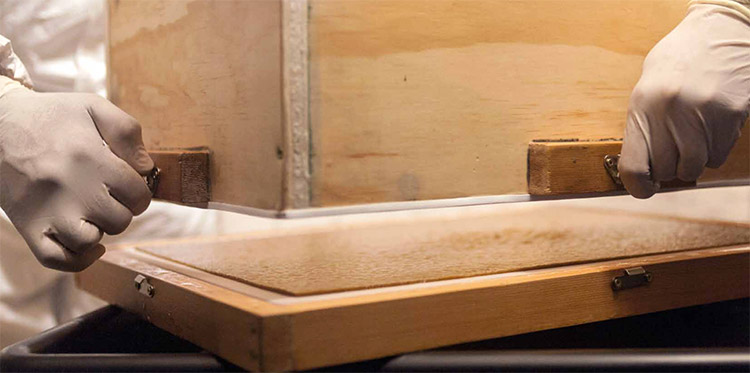
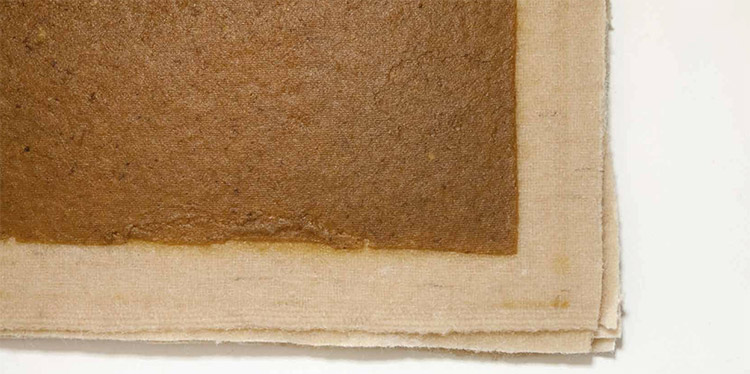
“Man Made Clouds is also a work of craft. Each book contains an ex libris made by hand from 100% organic tobacco, specially cultivated in the soil of Pollinaria, Abruzzo, Italy. Each tobacco leaf was dried, cooked and transformed into paper using artisanal paper-making techniques. In this single page two artefacts meet: paper as a carrier of information and tobacco ready for consumption. Man Made Clouds is a book about the image of man-made emissions and it is an object which can, at least in part, volatilise into the air. Please smoke.
“This is the story of the quest to create a fully smokeable paper for use in the book Man Made Clouds, made solely from 100% organic Nicotiana tabacum bre. In the course of its production this archival pH neutral paper has only been in temporary contact with soda ash, organic vinegar and water and has no other ingredients than the walnut ink used to stamp its logo. The tobacco leaves were cultivated, cropped and cured in Italy, and then cooked, pulped, moulded, pressed, dried and trimmed into A6 sheets in England. This would be the rst ever page of organic tobacco paper, free of additives.
“In August 2009, during their residency at Pollinaria to begin work on the Man Made Clouds book, HeHe proposed to farm organic tobacco to make paper for the book. In November 2009 the first tobacco paper production meeting took place at Cartiera Artem factory in Fabriano, the historical centre of Italian paper-making, and by February 2010 the rst prototypes were produced. Meanwhile land was prepared at Pollinaria, and in May forty-nine people gathered to plant one thousand ve hundred and sixty organic Burley tobacco seedlings. Between July and October that year four harvests of tobacco leaves were made, which were hung to dry and cure.
“Prototypes of paper made from these leaves were found to be too brittle and weak. HeHe conducted experiments in their Paris kitchen, using apple pectin and alginic acid in the process. In September 2012 Vaseem Bhatti at EHQuestionmark studio, Pollinaria’s creative director based in Manchester, o ered to build a tobacco paper research and production facility from scratch. In April 2014 the first shipment of tobacco leaves arrived in England from Italy. Research continued throughout June and July 2014 into methods of cooking the leaves, building utensils and experimenting with drying processes, in spite of a number of setbacks including a burglary, the presence of Lasioderma serricorne (tobacco eating beetle), a refusal to share knowledge by the Paper Science department at Manchester University’s School of Materials due to a blanket ban on all tobacco related research and the problem of extracting toxic fumes from the workshop after a case of nicotine poisoning.
“In December, the Greater Manchester Police Drug Squad made a surprise dawn raid on the factory, suspecting the cultivation of drugs, then bizarrely, that the paper being manufactured was intended to conceal illicit substances. All charges against Vaseem Bhatti were eventually dropped, as the sniffer dogs’ evidence came up negative.
“By June 2015 the new tobacco paper production was nalised. One hand-made page is enclosed within this book.”
(…)
“Smoke signals”
HeHe (pages 77 à 79)
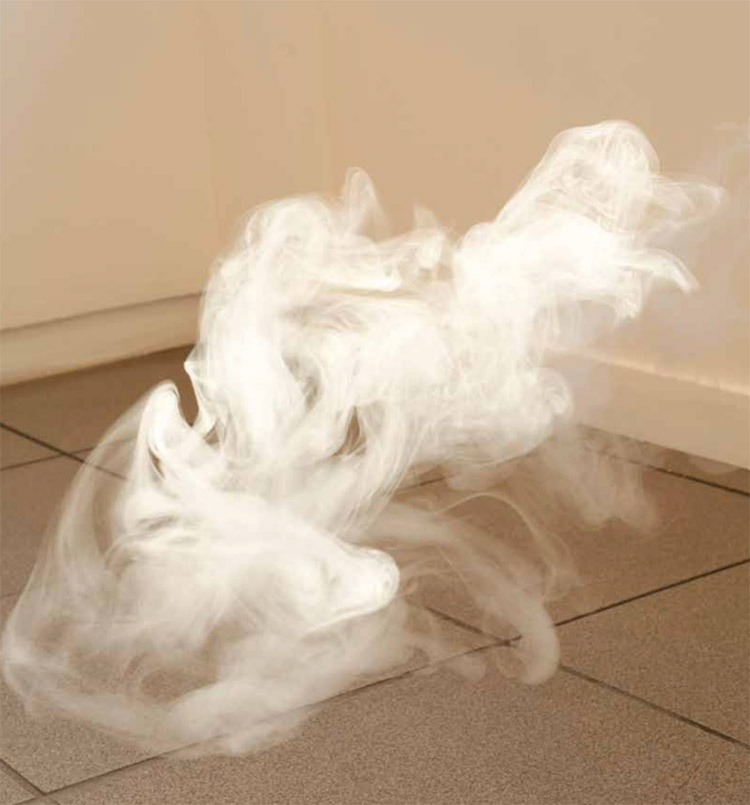
“The healthy, clean alternative to tobacco is emphasized by the vaping industry and its community. Designed to be more socially acceptable than its predecessor, at first glance it lacks the symbolic power to provoke. The ideological challenge posed by the self-portrait of the artist smoking is replaced by the vapid narcissism of the vaping selfie contest. It has however spawned a subculture— founded by the user–maker community who tinker and hack the technology and make it their own. Among their exploits is ‘cloud chasing’ which involves modifying heating elements and increasing battery power to produce even bigger, denser clouds. For dedicated cloud chasers, the vapouriser moves beyond its primary function as a drug distribution device. It is the feeling of clouds filling the lungs and the sublime spectacle of clouds forming out of the mouth that becomes an end in itself. It is pure visual pleasure: vaping for vape’s sake. Where adolescent cigarette smokers of previous generations prided themselves on their ability to blow a smoke ring, for young vapers the cloud formation trick repertoire includes cheerios, atomic mushrooms, french inhale, dragons, tornadoes and ghosts. Millions of images of spectacular vaping tricks are shared and commented upon online.
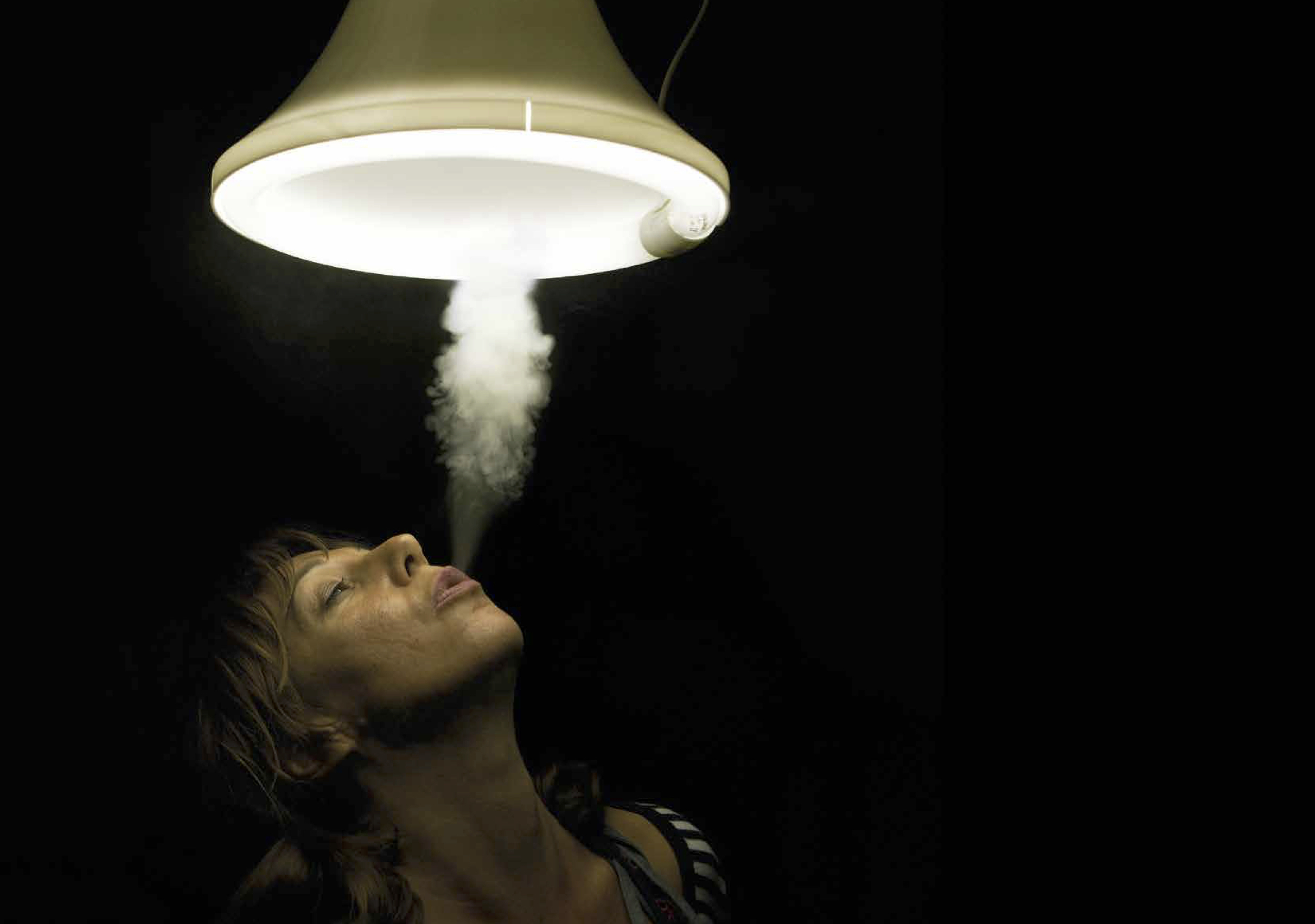
“The cloud chasing phenomenon goes beyond the functional into the realms of irrational pleasure. Vape clouds are increasingly questioned by regulating authorities as they are not controlled and do not fit established codes of practice. As a counter-tactic, the ‘stealth vape’ has been created: to vape without vapour–with the stated aim to make vaping less detectable. The idea behind this is to permit vaping in situations when ‘blowing billowing vapour clouds might not be appropriate, for instance at work, out at night or maybe while traveling’ (Jimmy Hafrey, New E-Liquid Promises Invisible Vapor for Discreet Vaping, 2014). Slowly, through practice in everyday life, a design language and culture evolves and perhaps the electronic cigarette might have the potential to embody challenging socio-political ideas, just like its more combustible predecessors.
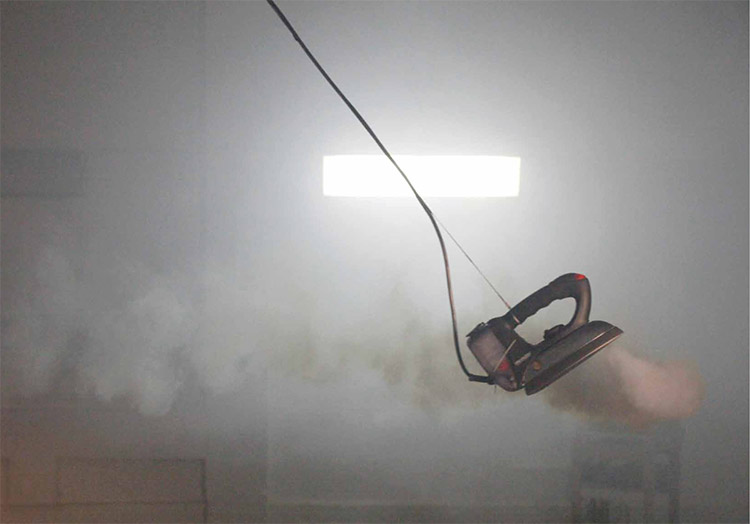
“The chemical substance that evaporates to form vaping clouds is propylene glycol, which was originally developed and tested during the second world war as an agent to eliminate air borne bacteria such as influenza. By the nineteen-fifties it was tested in hospital wards to disinfect the air and included as an important ingredient for decontamination fluids to be used in the event of biological warfare. (O. H. Robertson, Edward Bigg, Theodore T. Puck, Benjamin F. Miller, Elizabeth A. Appell, The bactericidal action of propylene glycol vapor on microorganisms suspended in air, 1942). Curiously, a chemical used to kill bacteria and prevent infection has become the main ingredient to deliver a new form of intoxication. Today, it is nicotine that is vaped, tomorrow we could be vaping smart new chemical substances.
“The spectacular foggy clouds made by evaporating glycols was invented as a special effect for the heterotopian space of the theatre. It was developed by engineer Günther Schaid, and curiously it was first tested in Nicolas Schoffer’s cybernetic lumino spectacle known as the Kyldex series, which was staged at the Hamburg State Opera in 1973. The existing fogs at the time were based on mineral oils, which represented a hazard to health and risk to cause fire. For safe use in theatres, a water based, non-toxic smoke was needed. In an interview, Schaid describes the context that led to his invention:
“Interestingly, the fog was not the task I had been asked to resolve. The opera hired me for my knowledge in the area of chemical effects because they needed a fragrance that was supposed to flood the space of the audience at the ‘erotic moment’. I composed a scent out of sandalwood and other ingredients—which today I mockingly call Eros Centre 6th floor—and afterwards the discussion happened to turn to theatre fog. I explained that I had developed a new procedure for fog to be deployed on theatre stages.”
Interview with Günther Schaid, HeHe, 2014.
“Although Schöffer did not imagine a society of electronic smokers, the dream of a future cybernetic society has today surely become true. We live in a world of technologically mediated possibilities whereby even the act of smoking has been replaced by an interactive system. Visual effects create the illusion of smoke, and the simulated experience is now connected and regulated by invisible feedback loops. In the process, even the smallest man-made clouds are altering human consciousness and transforming the way people think.”
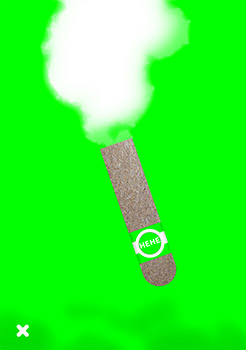
«Man Made Cloud», HYX editions, bilingual English-French, 496 pp. (texts from Jens Hauser, HeHe, Noortje Marres, Gunnar Schmidt, Malcom Miles and Jean-Marc Chomaz), September 2016, €30
